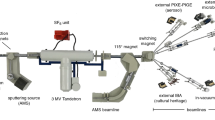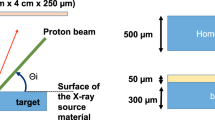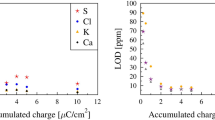Abstract
Supporting the knowledge of artworks, past times and civilizations by physics and, in general, sciences have been by now recognised to be a very valuable possibility, even though scientific measurements cannot definetely replace the historical and archaeological studies. In this framework, small particle accelerators, i.e., low voltage electrostatic systems, can play an important role for both material analysis and dating purposes. The present paper will present a review of the main principles of ion beam analysis, and in particular PIXE (Particle Induced X-ray Emission), for the study of the composition of artworks and of accelerator mass spectrometry for the measurement of 14C and dating. Advantages, limitations and outlooks are discussed.


Similar content being viewed by others
References
T. Calligaro, J.-C. Dran, J. Salomon, P. Walter, Review of accelerator gadgets for art and archaeology. Nucl. Instrum. Methods Phys. B 226(1–2), 29–37 (2004)
F. Lucarelli, How a small accelerator can be useful for interdisciplinary applications: the study of air pollution. Eur. Phys. J. Plus (2020). https://doi.org/10.1140/epjp/s13360-020-00516-3
P. Del Carmine, F. Lucarelli, P. Mandò, A. Pecchioli, The external PIXE setup for the analysis of manuscripts at the Florence University. Nucl. Instrum. Methods B 75, 480–484 (1993)
L. Giuntini, M. Massi, S. Calusi, The external scanning proton microprobe of Firenze: a comprehensive description. Nucl. Instrum. Methods A 576, 266–273 (2007)
V. Palonen, K. Mizohata, T. Nissinen, J. Räisänen, External beam IBA set-up with large-area thin Si3N4 window. Nucl. Instrum. Methods B 380, 11–14 (2016)
N. Grassi, P. Bonanni, C. Mazzotta, A. Migliori, P. Mandò, PIXE analysis of a painting by Giorgio Vasari. X-ray Spectrom. 38(4), 301–307 (2009)
C. Neelmeijer, M. Mäder, he merits of particle induced X-ray emission in revealing painting techniques. Nucl. Instrum. Methods B 189(1–4), 293–302 (2002)
V. Corregidor, A. Oliveira, P. Rodrigues, L. Alves, Paintings on copper by the Flemish artist FransFrancken II: PIXE characterization by external microbeam. Nucl. Instrum. Methods Phys. Res. Section B 348, 291–295 (2015)
P. Milota, I. Reiche, A. Duval, O. Forstner, H. Guicharnaud, W. Kutschera, S. Merchel, A. Priller, M. Schreiner, P. Steier, PIXE measurements of Renaissance silverpoint drawings at VERA. Nucl. Instrum. Methods B 266, 2279–2285 (2008)
P. Del Carmine, L. Giuntini, W. Hooper, F. Lucarelli, P. Mandò, Further results from PIXE analysis of inks in Galileo’s notes. Nucl. Instrum. Methods B 113, 354–358 (1996)
J. Duh, D. Krstić, D. Vladan, S. Fazinic, Non-destructive study of iron gall inks in manuscripts. Nucl. Instrum. Methods B 417, 96–99 (2018)
Q. Lemasson, B. Moignard, C. Pacheco, L. Pichon, M. Guerra, Fast mapping of gold jewellery from ancient Egypt with PIXE: Searching for hard-solders and PGE inclusions. Talanta 143, 279–286 (2015)
M. Vadrucci, A. Mazzinghi, A. Gorghinian, L. Picardi, M. Chiari, Analysis of Roman Imperial coins by combined PIXE, HE-PIXE and μ-XRF. Appl. Radiat. Isotopes 143, 35–40 (2019)
T. Calligaro, A. Mossmann, J.-P. Poirot, G. Querré, Race element fingerprinting of jewellery rubies by external beam PIXE. Nucl. Instrum. Methods B 150, 628–634 (1999)
A. Re, D. Angelici, A. Lo Giudice, E. Maupas, L. Giuntini, S. Calusi, N. Gelli, M. Massi, A. Borghi, L. Gallo, G. Pratesi, P. Mandò, New markers to identify the provenance of lapis lazuli: Trace elements in pyrite by means of micro-PIXE. Appl. Phys. A 111, 69–74 (2013)
S. Gama, M. Volfinger, C. Ramboz, O. Rouer, Accuracy of PIXE analyses using a funny filter. Nucl. Instrum. Methods B 181, 150–156 (2001)
Z. Török, R. Huszánk, L. Csedreki, J. Dani, Z. Szoboszlai, Development of a new in-air micro-PIXE set-up with in-vacuum charge measurements in Atomki. Nucl. Instrum. Methods B 362, 167–171 (2015)
A. Zucchiatti, A. Climent-Font, P. Gutiérrez-Nei, I. Montero-Ruiz, J. Fuenlabrada, C. Galindo, Amorphous glass fragments from archaeological surface surveys: potential chronological use of ion beam and isotopic analytical characterization. J. Archaeol. Sci. Rep. 19, 439–453 (2018)
L. Pichon, C. Moignard, Q. Lemasson, C. Pacheco, P. Walter, Development of a multi-detector and a systematic imaging system on the AGLAE external beam. Nucl. Instrum. Methods B 318, 27–31 (2014)
F. Taccetti et al., A multipurpose X-ray fluorescence scanner developed for in situ analysis. Rendiconti Lincei 30, 307–322 (2019)
A. Migliori, P. Bonanni, L. Carraresi, N. Grassi, P. Mandò, A novel portable XRF spectrometer with range of detection extended to low-Z elements. X-Ray Spectrom. 40, 107–112 (2011)
F. Rosi, C. Grazia, R. Fontana, F. Gabrieli, L. PensabeneBuemi, E. Pampaloni, A. Romani, C. Stringari, C. Miliani, Disclosing Jackson Pollock’s palette in Alchemy (1947) by non-invasive spectroscopies. Heritage Sci. 4, 18 (2016)
G. Mauran, M. Lebon, F. Détroit, B. Caron, A. Nankela, D. Pleurdeau, J.-J. Bahain, First in situ pXRF analyses of rock paintings in Erongo, Namibia: results, current limits, and prospects. Archaeol. Anthropol. Sci. 11, 4123–4145 (2019)
K. Trentelman et al., The examination of works of art using in situ XRF line and area scans. X-Ray Spectrom. 39, 159–166 (2010)
S. Valadas et al., Study of mural paintings using in situ XRF, confocal synchrotron-μ-XRF, μ-XRD, optical microscopy, and SEM-EDS—the case of the frescoes from Misericordia Church of Odemira. Microsc. Microanal. 17, 702–709 (2011)
P. Mandò, M. Fedi, N. Grassi, A. Migliori, Differential PIXE for investigating the layer structure of paintings. Nucl. Instrum. Methods B 239, 71–76 (2005)
N. Grassi, A. Migliori, P. Mandò, H. Calvo Del Castillo, Differential PIXE measurements for the stratigraphic analysis of the painting Madonna dei fusi by Leonardo da Vinci. X-Ray Spectrom. 34, 306–309 (2005)
Ž Šmit, J. Istenič, T. Knific, Plating of archaeological metallic objects studies by differential PIXE. Nucl. Instrum. Methods B 266, 2329–2333 (2008)
N. Grassi, Differential and scanning-mode external PIXE for the analysis of the painting RitrattoTrivulzio by Antonello da Messina. Nucl. Instrum. Methods B 267, 825–831 (2009)
T. Silva et al., Elemental mapping of large samples by external ion beam analysis with sub-millimeter resolution and its applications. Nucl. Instrum. Methods B 422, 68–77 (2018)
W. Kutschera, The Half-life of 14C—why is it so long? Radiocarbon 61, 1135–1142 (2019)
R. Taylor, O. Bar-Yosef, Radiocarbon Dating: An Archaeological Perspective (United Kingdom, Taylor & Francis Ltd, 2020).
R. Muller, Radioisotope dating with a cyclotron. Sci. 196, 489–494 (1977)
K. Purser et al., An attempt to detect stable N-ions from a sputter ion source and some implications of the results for the design of tandems for ultra-sensitive carbon analysis. Revue de Physique Appliquee 12, 1487–1492 (1977)
K. Purser, T. Litherland, Accelerator mass spectrometry: a remarkable week in May 1977. Nucl. Instrum. Methods B 479, 254–263 (2020)
C. Tuniz, J. Bird, D. Fink, G. Herzog, Accelerator Mass Spectrometry: Ultrasensitive Analysis for Global Science (Taylor & Francis Inc, United Kingdom, 1998).
M. Fedi, A. Cartocci, M. Manetti, F. Taccetti, P. Mandò, The 14C AMS facility at LABEC, Florence. Nucl. Instrum Methods B 259, 18–22 (2007)
H. Betz, Review of stripping of heavy ions. IEEE Trans. Nucl. Sci. 18, 1110–1114 (1971)
F. Barile et al., A C-14 beam monitor using silicon solid state sensor for cultural heritage. Nucl. Instrum. Methods A 936, 22–24 (2019)
A. Müller, M. Döbeli, M. Suter, H.-A. Synal, Performance of the ETH gas ionization chamber at low energy. Nucl. Instrum. Methods B 287, 94–102 (2012)
A.-H. Synal, M. Stocker, M. Suter, MICADAS: A new compact radiocarbon AMS system. Nucl. Instrum. Methods B 259, 7–13 (2007)
T. Schulze-König et al., The dissociation of 13CH and 12CH2 molecules in He and N2 at beam energies of 80–250 keV and possible implications for radiocarbon mass spectrometry. Nucl. Instrum. Methods B 269, 34–39 (2007)
G. Prasad, J. Noakes, A. Cherkinsky, R. Culp, D. Dvoracek, The New 250kV single stage AMS system at CAIS, University of Georgia: performance comparison with a 500kV compact tandem machine. Radiocarbon 55, 319–324 (2013)
C. Bronck Ramsey, Radiocarbon dating: revolutions in understanding. Archaeometry 50, 249–275 (2008)
P. Fabbri, Middle paleolithic human deciduous incisor from Grotta del Cavallo, Italy. Am. J. of Phys. Anthropol. 161, 506–512 (2016)
L. Caforio et al., Discovering forgeries of modern art by the 14C Bomb Peak. EPJ Plus 129, 6 (2014)
I. Hajdas et al., Bomb 14C on paper and detection of the Forged Paintings of T’ang Haywen. Radiocarbon 61, 1905–1912 (2019)
S. Mathot, The CERN PIXE-RFQ, a transportable proton accelerator for the machina project. Nucl. Instrum. Methods B 459, 153–157 (2019)
P. Steier, J. Liebl, W. Kutschera, E.M. Wild, R. Golser, Preparation methods of µg carbon samples for 14C measurements. Radiocarbon 59, 803–814 (2017)
M. Ruff, S. Fahrni, H. Gäggeler, I. Hajdas, M. Suter, H. Synal, S. Szidat, L. Wacker, On-line radiocarbon measurements of small samples using elemental analyzer and MICADAS gas ion source. Radiocarbon 52, 1645–1656 (2010)
M. Fedi, S. Barone, F. Barile, L. Liccioli, M. Manetti, L. Schiavulli, Towards micro-samples radiocarbon dating at INFN-LABEC, Florence. Nucl. Instrum. Methods B 465, 19–23 (2020)
Author information
Authors and Affiliations
Corresponding author
Rights and permissions
About this article
Cite this article
Fedi, M. How a small accelerator can be useful for interdisciplinary applications part II: cultural heritage studies. Eur. Phys. J. Plus 136, 411 (2021). https://doi.org/10.1140/epjp/s13360-021-01334-x
Received:
Accepted:
Published:
DOI: https://doi.org/10.1140/epjp/s13360-021-01334-x




